Key takeaways:
- Blockchain interoperability enables seamless communication and asset transfer across different blockchain networks, enhancing user experience and technology adoption.
- Current solutions include cross-chain bridges, interoperable platforms like Polkadot and Cosmos, and layer-two solutions, each offering unique benefits and challenges.
- Key challenges to achieving interoperability are the lack of standard protocols, security concerns, and differing governance structures among blockchains.
- The future of interoperability looks promising with emerging protocols, liquidity bridges, and the potential for universal frameworks to facilitate communication across all blockchains.
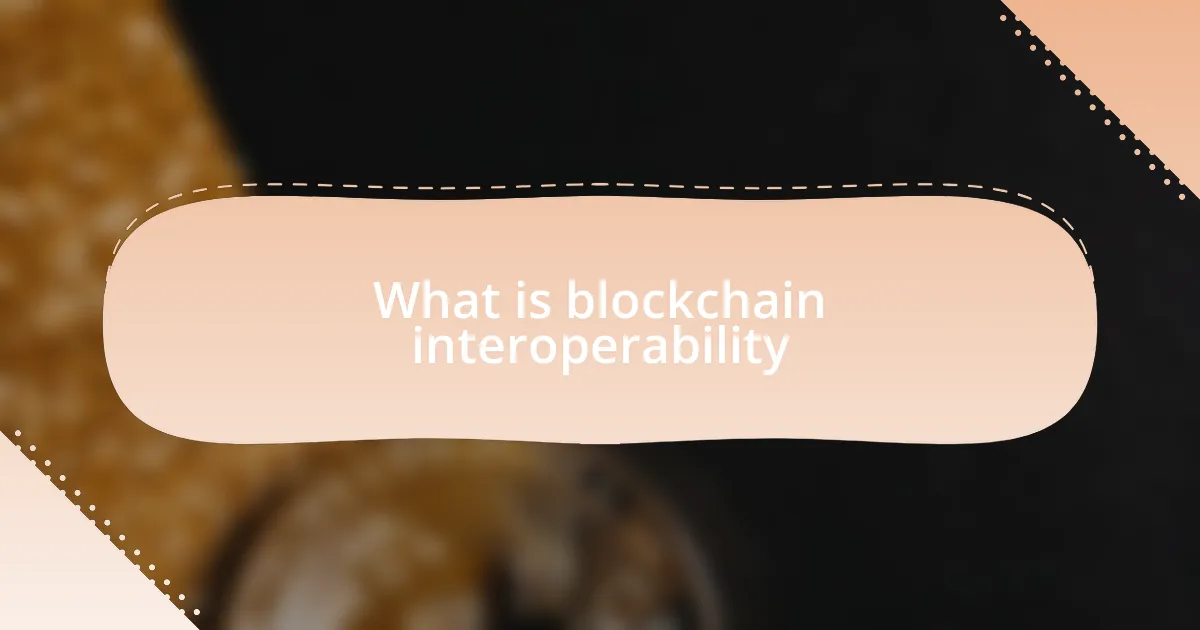
What is blockchain interoperability
Blockchain interoperability refers to the ability of different blockchain networks to communicate and interact with each other seamlessly. This connectivity allows users to transfer assets and data across various platforms, enhancing the overall ecosystem. I often find myself wondering about the potential for this technology—how much more efficient could transactions be if we could harness this kind of collaboration among chains?
When I think about interoperability, I recall a time when I was trying to transfer assets between two different blockchain networks. The process was convoluted and frustrating, making me realize the significance of seamless communication between platforms. Imagine a world where you could swap cryptocurrencies or NFTs across networks without the hassle of multiple exchanges—this is what true interoperability promises.
Ultimately, the essence of blockchain interoperability lies in creating a more user-friendly experience and increasing the overall adoption of blockchain technology. It’s an exciting frontier that not only paves the way for innovative applications but also invites us to rethink how we engage with digital assets across diverse platforms.

Importance of interoperability in cryptocurrency
When I reflect on the importance of interoperability in cryptocurrency, I’m reminded of how frustrating it can be to navigate different wallets and exchanges. Each time I needed to switch networks, it felt like going through a labyrinth. If blockchain networks could seamlessly interact, it would eliminate those headaches and allow users to transfer assets with ease. Wouldn’t it be incredible if we could effortlessly send tokens across various chains without delays or complicated steps?
Interoperability isn’t just about convenience; it’s about expanding the horizons of what we can achieve with blockchain technology. I remember attending a conference where a developer shared his vision for cross-chain applications. He painted a picture of a world where decentralized finance (DeFi) could flourish unrestricted by network boundaries. This vision resonated with me, as it highlighted how much potential lies in connecting disparate ecosystems. Isn’t the idea of limitless possibilities thrilling?
Moreover, interoperability stands as a crucial pillar in boosting trust and security within the cryptocurrency space. With interconnected platforms, users can verify and track transactions more reliably across networks. I’ve experienced moments of uncertainty while trading, wondering if I was missing out on security by sticking to a single blockchain. Imagine a scenario where users can confidently engage across various platforms, assured that their assets are safe and easily transferable. This level of trust could significantly enhance user adoption, wouldn’t you agree?
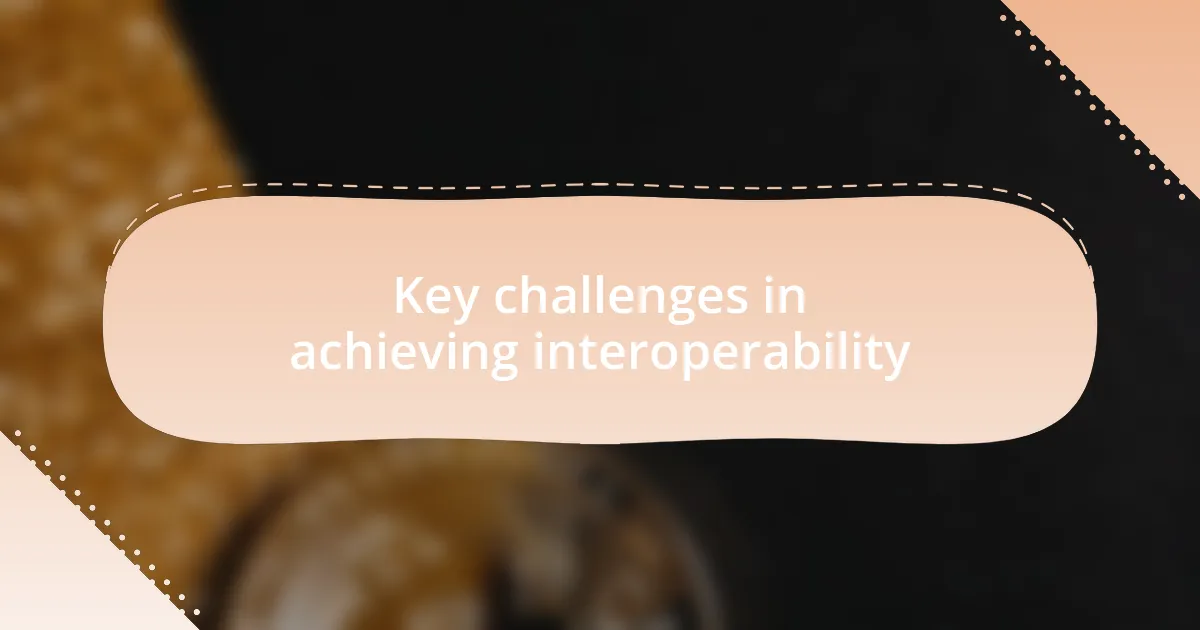
Key challenges in achieving interoperability
One of the primary challenges in achieving interoperability is the lack of standardized protocols across different blockchain networks. I recall a time when I tried to transfer assets between two prominent chains, only to find that each had its own set of rules and formats. This disparity in technical specifications can create bottlenecks, making it challenging for developers to build applications that work seamlessly across platforms. How can we expect users to embrace a multi-chain future if the very foundations of these networks don’t align?
Additionally, security concerns often loom large when discussing interoperability. In my experience, linking multiple blockchains can expose systems to various vulnerabilities. I remember reading about a cross-chain project that fell prey to a hacking incident, which left many users shaken. It made me think—how can we ensure that as we strive for unity, we don’t inadvertently compromise the integrity of individual networks? Each connection must be fortified with robust security measures to inspire confidence among users.
Finally, the issue of governance cannot be overlooked. Different blockchains often have distinct governance structures, which complicates collaborative efforts. From my perspective, I find the idea of reaching a consensus across diverse ecosystems daunting. It reminds me of a time when my local community struggled to unite over a shared issue; if we couldn’t agree on the same approach in something as small as neighborhood concerns, how could we collaborate on a global scale? Until we find a way to harmonize governance models, achieving true interoperability will remain a complex and uphill battle.
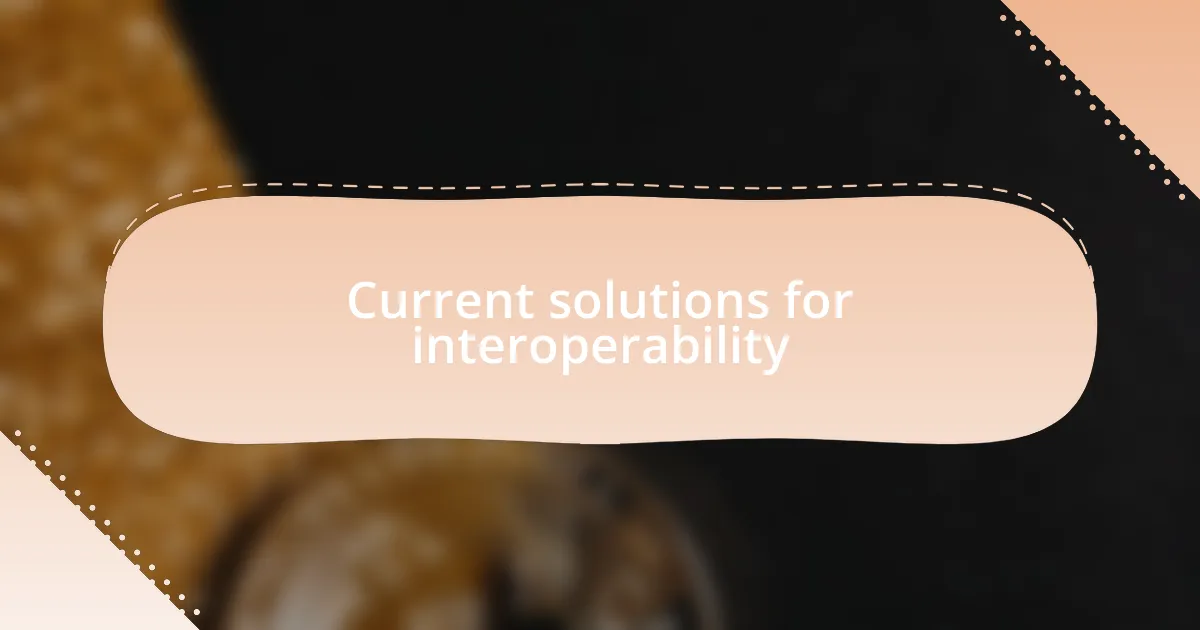
Current solutions for interoperability
Current solutions for interoperability have emerged in various forms, each with unique strengths and weaknesses. One notable solution is the use of cross-chain bridges that enable the transfer of assets between different blockchains. I remember the first time I utilized a bridge to move my tokens—it was both thrilling and nerve-wracking. Watching my assets traverse different networks reminded me of a tightrope walker balancing between two skyscrapers. Would it make it safely?
Another approach lies in protocols like Polkadot and Cosmos, which are designed specifically for interoperability. These platforms offer a framework allowing multiple blockchains to interact and share data seamlessly. It was enlightening for me to explore how these networks facilitate communication; they seem to be the connective tissue that could hold the blockchain ecosystem together. But I wondered, could these solutions be the ultimate answer to the disjointed nature of existing networks?
Lastly, layer-two solutions, such as Lightning Network for Bitcoin, provide additional pathways for interoperability by allowing transactions to occur off the main chain. In my earlier explorations of Bitcoin, I often found myself frustrated with transaction speeds. Learning about layer-two solutions felt like discovering a hidden highway on a crowded map. However, it raised a question in my mind: as we traverse these new avenues, do they truly offer the scalability we need, or are we merely masking the underlying issues?
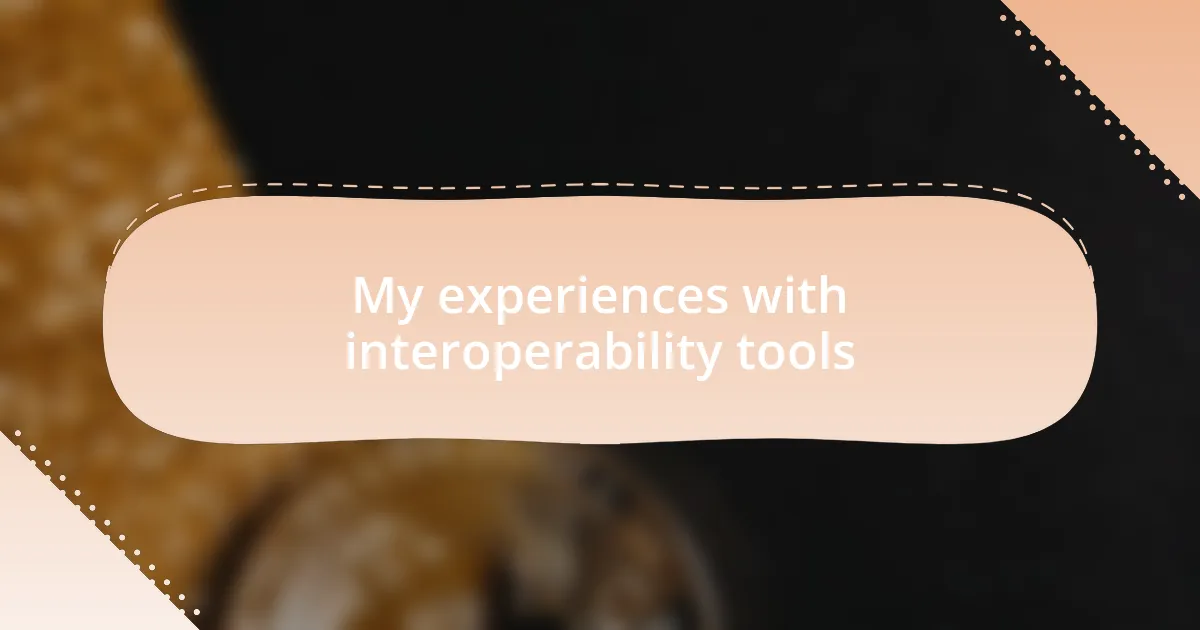
My experiences with interoperability tools
My journey with interoperability tools has been eye-opening. When I first experimented with a cross-chain DEX, I felt a mix of excitement and uncertainty. The ability to swap tokens across different platforms made me appreciate the sheer potential of this technology. It was like stepping into a digital marketplace that brought together diverse products from different regions, but I couldn’t shake the thought—how secure are these transactions, really?
On another occasion, diving into the Polkadot ecosystem was a revelation. The first time I interacted with one of its parachains, the seamlessness of connecting with other blockchains struck me as almost magical. I found myself thinking, why hadn’t this been implemented sooner? It felt like meeting a long-lost friend who shared connections with so many people in my life. It truly made me realize how vital these interoperability solutions are for the future of decentralized ecosystems.
I also had some hands-on experience with layer-two solutions like the Lightning Network. I recall the day I made my first off-chain transaction; it was a game-changer. The speed was astonishing, but I confronted an uncomfortable realization: would I trust these ephemeral connections enough for significant transactions? This question hung in the air as I pondered the balance between innovation and security in pursuing interoperability.
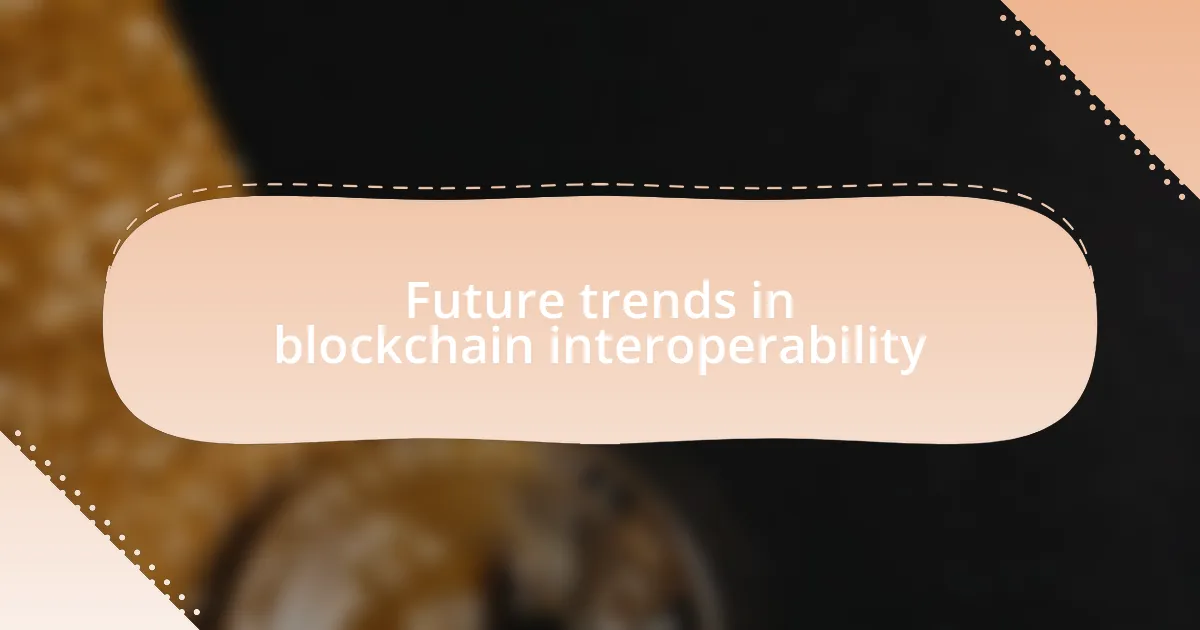
Future trends in blockchain interoperability
The future of blockchain interoperability appears promising, with emerging protocols focusing on enhancing seamless communication between different networks. Recently, I reflected on the day I witnessed a demo of a multichain architecture that showcased how users could transact effortlessly across chains. It struck me then—what if we could one day navigate this blockchain landscape as easily as checking our social media?
In my observations, liquidity bridges are also gaining traction as developers seek to create secure connections between various DeFi ecosystems. During a recent interview with a developer working on one such bridge, I found myself pondering the implications: could these innovations attract a wave of new users who once felt intimidated by the complexities of crypto? The thought excites me, as it opens the door to greater adoption and inclusivity in the crypto space.
Moreover, I can’t help but wonder about the role of interoperability standards in shaping the future landscape. Picture a world where a universal framework allows any blockchain to communicate effortlessly, regardless of its architecture. This vision excites me because it would mean not just better user experiences, but also heightened collaboration across projects. Could this be the catalyst for the next big wave of innovation in our industry?
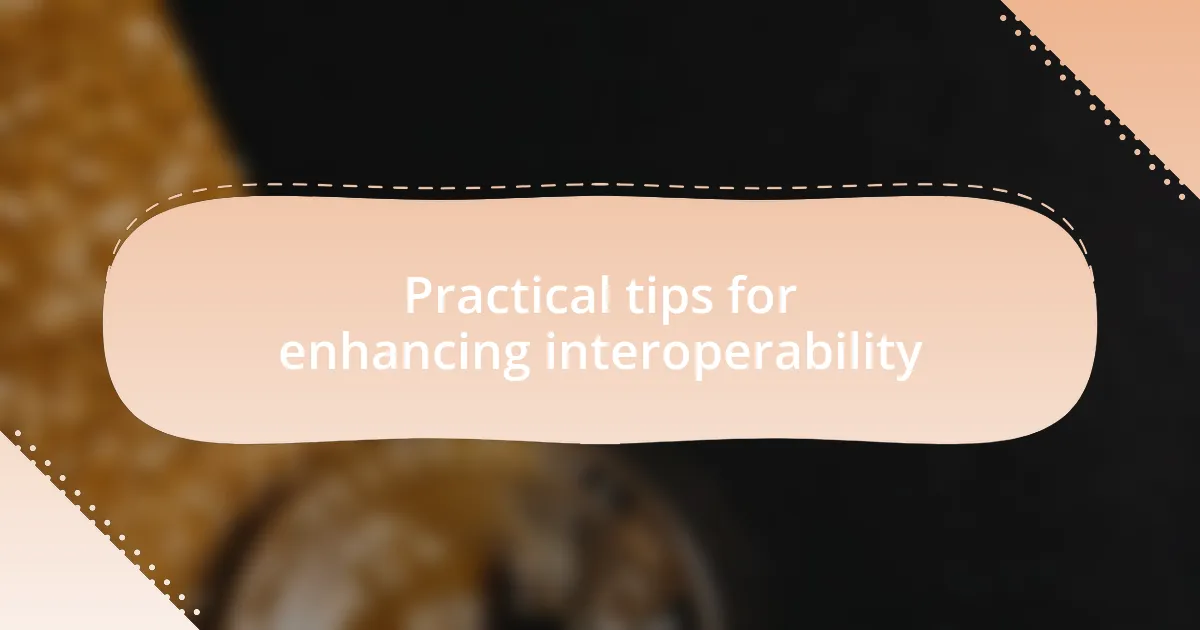
Practical tips for enhancing interoperability
One practical approach to enhancing blockchain interoperability is adopting open-source protocols. I remember when I first encountered a project leveraging open-source frameworks—it was like discovering a vibrant community working together. This collaborative spirit not only fosters innovation but also encourages a shared understanding, allowing different systems to communicate more effectively. Have you ever thought about how collaboration in tech can create a seamless environment?
Another way to improve interoperability is through the use of middleware solutions. These tools can act as translators between different blockchains, allowing for smooth exchanges of data. I once attended a workshop where we experimented with middleware, and it was enlightening to see how efficiently various chains could interact. It made me reflect on the potential of these solutions to turn complex transactions into a walk in the park.
Finally, prioritizing education and awareness around interoperability is crucial. When I speak with newcomers in the cryptocurrency space, I often see their eyes light up when they grasp the concept of cross-chain transactions. It’s vital to create more educational resources—imagine the impact of well-informed users advocating for interoperable solutions. Are we doing enough to bridge the knowledge gap that still exists?